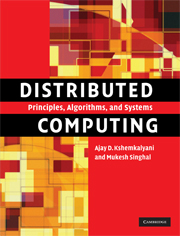Book contents
- Frontmatter
- Contents
- Preface
- 1 Introduction
- 2 A model of distributed computations
- 3 Logical time
- 4 Global state and snapshot recording algorithms
- 5 Terminology and basic algorithms
- 6 Message ordering and group communication
- 7 Termination detection
- 8 Reasoning with knowledge
- 9 Distributed mutual exclusion algorithms
- 10 Deadlock detection in distributed systems
- 11 Global predicate detection
- 12 Distributed shared memory
- 13 Checkpointing and rollback recovery
- 14 Consensus and agreement algorithms
- 15 Failure detectors
- 16 Authentication in distributed systems
- 17 Self-stabilization
- 18 Peer-to-peer computing and overlay graphs
- Index
10 - Deadlock detection in distributed systems
Published online by Cambridge University Press: 05 June 2012
- Frontmatter
- Contents
- Preface
- 1 Introduction
- 2 A model of distributed computations
- 3 Logical time
- 4 Global state and snapshot recording algorithms
- 5 Terminology and basic algorithms
- 6 Message ordering and group communication
- 7 Termination detection
- 8 Reasoning with knowledge
- 9 Distributed mutual exclusion algorithms
- 10 Deadlock detection in distributed systems
- 11 Global predicate detection
- 12 Distributed shared memory
- 13 Checkpointing and rollback recovery
- 14 Consensus and agreement algorithms
- 15 Failure detectors
- 16 Authentication in distributed systems
- 17 Self-stabilization
- 18 Peer-to-peer computing and overlay graphs
- Index
Summary
Introduction
Deadlocks are a fundamental problem in distributed systems and deadlock detection in distributed systems has received considerable attention in the past. In distributed systems, a process may request resources in any order, which may not be known a priori, and a process can request a resource while holding others. If the allocation sequence of process resources is not controlled in such environments, deadlocks can occur. A deadlock can be defined as a condition where a set of processes request resources that are held by other processes in the set.
Deadlocks can be dealt with using any one of the following three strategies: deadlock prevention, deadlock avoidance, and deadlock detection. Deadlock prevention is commonly achieved by either having a process acquire all the needed resources simultaneously before it begins execution or by pre-empting a process that holds the needed resource. In the deadlock avoidance approach to distributed systems, a resource is granted to a process if the resulting global system is safe. Deadlock detection requires an examination of the status of the process–resources interaction for the presence of a deadlock condition. To resolve the deadlock, we have to abort a deadlocked process.
In this chapter, we study several distributed deadlock detection techniques based on various strategies.
System model
A distributed system consists of a set of processors that are connected by a communication network. The communication delay is finite but unpredictable.
Information
- Type
- Chapter
- Information
- Distributed ComputingPrinciples, Algorithms, and Systems, pp. 352 - 378Publisher: Cambridge University PressPrint publication year: 2008
